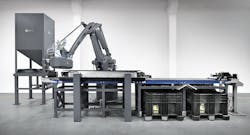The Sand Printing Technology for Every Foundry
Additive manufacturing has been in development for decades, and it began to be adopted on a production scale over 10 years ago. The principles are well established, but AM’s practical influence in metalcasting has been somewhat low-key: printing molds and cores in wax has benefitted some investment casters, and likewise tooling for patternmakers, but printing sand mixtures has been effective mainly for foundries that need a core or mold on a quick-turnaround, or those operations that cast predictable designs and series volumes.
ExOne Co. is probably the most recognizable supplier of sand printing systems for North American foundries, having introduced its S-Max series of binder-jet systems in 2011, for producing molds and cores in cold-hardening bonded sand. Now, ExOne has revealed a new S-Max entry, S-Max Flex, “for foundries stepping into the next era of digital casting.”
“To achieve our vision of Additive Manufacturing 2.0, we need to make production 3D printing practical in terms of speed, cost, and material availability for a broad range of applications,” according to Ric Fulop, co-founder and CEO of Desktop Metal, the AM developer that acquired ExOne last year in a private transaction estimated at $575 million.Now, Desktop Metal’s binder-jet printing process is technically sound, but the news surrounding the new system is that it can be customized to work successfully for foundries of various sizes, with different resources and market orientations.
“We designed the all-new S-Max Flex from the ground-up, leveraging SPJ technology with the idea of making premium, sand 3D-printing accessible to every foundry, so that more companies can take advantage of the benefits of AM 2.0, such as distributed, local production, and remain competitive for the long term,” Fulop continued.
The Single-Pass Jetting™ (SPJ) technology combines four steps of binder jet printing – laying powder (or sand) on the build plate; spreading and compacting the build material; applying the binder for each layer of the form as indicated by a CAD program; and drying the binder – so that each layer is completed in as little as three seconds, according to Desktop Metal.
As unveiled in April, the S-Max® Flex is an apparently simple arrangement: No cabinet or enclosed chamber, as for past S-Max systems, but a telescoping build box that lowers and expands to hold parts as they are formed; and a standard industrial robot to execute the binder-jetting process.
The robot’s end effector is the printhead for the SPJ technology, depositing furan binder into the sand according to the CAD pattern, defining each layer of the mold or core design.
The build box expands up to 1,900×1,000×1,000 mm (74×39×39 in.), with larger sizes available up to 4,700×1,000×1,000 mm (185×39×39 in), and taller versions up to 1,000×2,500×2,400 mm (39×98×94 in.)
The speed of the SPJ process allows the S-Max Flex to maintain a build rate of 115 liters/hour, printing sand shapes that have a dimensional accuracy of +/- 0.5 mm, according to the developer.
Though the formal introduction is now official, ExOne’s new sand printer has already been adopted by at least four foundries: Alpha Foundry, Wright City, MO; D.W. Clark, Taunton, MA; Founders Service and Manufacturing Cop, Deerfield, OH; and HTCI Co., New Carlisle, OH.
The real-world examples help to confirm ExOne’s emphasis on the S-Max Flex’s flexibility – not only for different product applications but for the space, labor, and cost requirements of different foundries.

